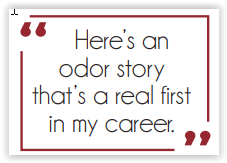What’s that Smell?
STRANGE STORIES OF CHASING ODORS
 Of all the work I do with indoor air quality (IAQ), chasing odors tends to lead to some of the strangest stories. It’s not my favorite part of my job, but when a client calls with an odor problem, I’m not going to leave them hanging. Recently I had two specific incidences that highlight the strange nature of chasing odors.
Of all the work I do with indoor air quality (IAQ), chasing odors tends to lead to some of the strangest stories. It’s not my favorite part of my job, but when a client calls with an odor problem, I’m not going to leave them hanging. Recently I had two specific incidences that highlight the strange nature of chasing odors.
Interior Decorating Gone Wrong
When tenants in a new building began reporting a bad odor in the elevator lobby and reception area of the third floor, the building’s general contractor hired me to help.
The tenants and building manager thought the odor was coming from the HVAC system, but if that were the case, the odor would have spread across a large portion of the floor. Since the building was only three months old, I initially suspected the glues, dyes, or some other materials used in the construction process could have been creating the odor. However, when I reviewed the material safety sheet, I couldn’t find anything that would cause the problem. The same chemicals and materials had been used on the other floors, but only the third floor had the odor.
Trying to work through the whole thing in my mind, I took another look at the area. In the reception area, there were two chairs and a round coffee table. This brand-new furniture had been purchased by a tenant, and I suggested it be relocated.
“Humor me,” I said. “I’ll do more research, but in the meantime, move those chairs and the coffee table into an empty office and see what goes on in there.”
They moved the furniture on a Thursday. The following week, the guy from the GC (the term stands for general contractor) called to tell me the odor was no longer in the elevator or reception area. When I asked where it had gone, he reported that the odor had followed the furniture into the empty office. I didn’t pat myself on the back the source had been pretty low-hanging fruit, in my opinion.
Sounds like the end of the story, right? Well, jump ahead to 10 days later, and I found myself in a continuing education class with another IAQ investigator. This guy tells me that he just read my furniture report. When I asked why he read it, he told me the tenant had hired him because the odor came back. I was surprised until he mentioned that the tenant moved some different furniture to the third-floor reception area.
This really got to me. The tenants got it in their heads that it was just the original two chairs and round coffee table that had the odor. So when they brought in new furniture — probably from the same supplier — and the odor came back, they couldn’t solve the problem on their own. They failed to see the simple solution that a bunch of furniture might smell bad.
I told the guy to have the tenant move the new furniture again and see what happens.
IAQ isn’t rocket science unless you need it to be. Most of the time, common sense is all you need when chasing odors.
The Human Factor
Here’s an odor story that’s a real first in my career. 
A couple months ago, a small group of tenants in an office building began complaining about a vomit-like smell around their desks. The building manager immediately brought in carpet cleaners on a Friday afternoon and checked the A/C system and the ceiling tiles for the source of the smell. They found nothing, but on Monday morning, the smell was gone. Then on Tuesday, the odor was back. That’s when the building manager called me.
Sure enough, when I walked over to the desks of the tenants who had been complaining, there was a light vomit smell in the air. When I got on my hands and knees, it became clear the smell was coming from the carpet, despite the carpets being cleaned less than a week prior. There was one woman’s desk in particular where the smell was extremely strong. I’ll call this woman Janet.
Since it wasn’t the ceiling or A/C system, I began to suspect it might have been a tenant-caused issue. I looked around the area and noted one desk with some foodstuff — it was possible some spilled olive oil was the source. I also couldn’t rule out that Janet might have been bringing something in on her shoes.
When I wrote my report, I recommended cleaning the carpets again, moving the people who had been complaining to another area, and seeing if the odor returned. I didn’t know the source, but if it was a tenant-caused issue, the odor might move with the occupants. Later, I found out that the building owner gave my report to the tenant, who then gave it to their HR manager. HR decided the best approach was to move their staff and then hide a camera in that area and see what was up. Not to sound like clickbait, but what they found surprised even me.
The camera got footage of the man who sat next to Janet spraying some sort of compound on the floor around her desk. That was the source of the odors! HR scheduled a meeting to talk about the issue with him, and he abruptly quit the day before the meeting. The tenant didn’t know what the compound was because they couldn’t find the bottle, but the odor and the problem disappeared after that.
There are a lot of things building owners and property managers can do to maintain IAQ in their buildings, but one thing they can’t control is whether the people who work together will get along. It appears this man really didn’t like sitting next to Janet and was trying to make her quit.
In all my years of chasing odors, I’d never run into a problem quite like this before.
There are two key points building owners and property managers can take away from my experiences.
First, don’t make IAQ harder than it has to be. If there’s low-hanging fruit, that’s probably the source of the problem.
Second, never underestimate the levels of human pettiness.

